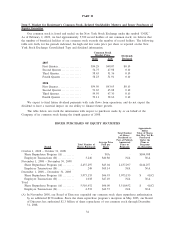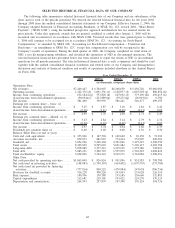Quest Diagnostics 2008 Annual Report Download - page 55
Download and view the complete annual report
Please find page 55 of the 2008 Quest Diagnostics annual report below. You can navigate through the pages in the report by either clicking on the pages listed below, or by using the keyword search tool below to find specific information within the annual report.as California, healthcare plans may delegate their covered members to independent physician associations
(“IPAs”), which in turn negotiate with laboratories for clinical testing services on behalf of their members.
The trend of consolidation among physicians, hospitals, employers, healthcare plans, pharmaceutical
companies and other intermediaries has continued, resulting in fewer but larger customers and payers with
significant bargaining power to negotiate fee arrangements with healthcare providers, including clinical
laboratories. Healthcare plans often require that clinical testing service providers accept discounted fee structures
or assume all or a portion of the utilization risk associated with providing testing services to their members
enrolled in highly-restricted plans through capitated payment arrangements. Under these capitated payment
arrangements, we and the healthcare plans agree to a predetermined monthly reimbursement rate for each member
enrolled in the healthcare plan’s restricted plan, generally regardless of the number or cost of services provided
by us. Our cost to perform work reimbursed under capitated payment arrangements is not materially different
from our cost to perform work reimbursed under other arrangements with healthcare plans. Since average
reimbursement rates under capitated payment arrangements are typically less than our overall average
reimbursement rate, the testing services reimbursed under capitated payment arrangements are generally less
profitable. In 2008, we derived approximately 14% of our testing volume and 5% of our net revenues from
capitated payment arrangements.
Most healthcare plans also offer programs such as preferred provider organizations (“PPOs”) and consumer
driven health plans that offer a greater choice of healthcare providers. Pricing for these programs is typically
negotiated on a fee-for-service basis, which generally results in higher revenue per requisition than under
capitation arrangements. Most of our agreements with major healthcare plans are non-exclusive arrangements. As
a result, under these non-exclusive arrangements, physicians and patients have more freedom of choice in
selecting laboratories, and laboratories are likely to compete more on the basis of service and quality than they
may otherwise. If consumer driven plans and PPO plans continue to increase in popularity, it will be increasingly
important for healthcare providers to differentiate themselves based on quality, service and convenience to avoid
competing on price alone.
Despite the general trend of increased choice for patients in selecting a healthcare provider, recent
experience indicates that some healthcare plans may actively seek to limit the choice of patients and physicians if
they feel it will give them increased leverage to negotiate lower fees, by consolidating services with a single or
limited network of contracted providers. Historically, healthcare plans, which had limited their network of
laboratory service providers, encouraged their members, and sometimes offered incentives, to utilize only
contracted providers. Patients who use a non-contracted provider may have a higher co-insurance responsibility,
which may result in physicians referring testing to contracted providers to minimize the expense to their patients.
In cases where members choose to use a non-contracted provider due to service quality or convenience, the non-
contracted provider would be reimbursed at rates considered “reasonable and customary.” Contracted rates are
generally lower than “reasonable and customary” rates because of the potential for greater volume as a contracted
provider. A non-contracted laboratory service provider with quality and service preferred by physicians and
patients to that of contracted providers, could potentially realize greater profits than if it was a contracted
provider, provided that physicians and patients continue to have choice in selecting their provider, and any
potential additional cost to the patient of using a non-contracted provider is not considered prohibitive. Physicians
requiring testing for patients are the primary referral source of our clinical testing volume, and often refer work
to us as a non-contracted provider.
We expect that reimbursements for the diagnostic testing industry will continue to remain under pressure.
Today, the federal and many state governments face serious budget deficits and healthcare spending is subject to
reductions, and efforts to reduce reimbursements and stringent cost controls by government and other payers for
existing tests may continue. However, we believe that as new tests are developed which either improve on the
effectiveness of existing tests or provide new diagnostic capabilities, government and other payers will add these
tests as covered services, because of the importance of laboratory testing in assessing and managing the health of
patients. We continue to emphasize the importance and the high value of laboratory testing with healthcare plans
and government payers at the federal and state level.
Our Company
Quest Diagnostics is the world’s leading provider of diagnostic testing, information and services, providing
insights that enable patients, physicians and others to make decisions to improve health. Quest Diagnostics, with
a leading position in most of its domestic geographic markets and service offerings, is well positioned to benefit
from the long-term growth expected in the industry. Over 90% of our revenues are derived from clinical testing
with the balance derived from insurer services, clinical trials testing, diagnostic products and healthcare
43
























